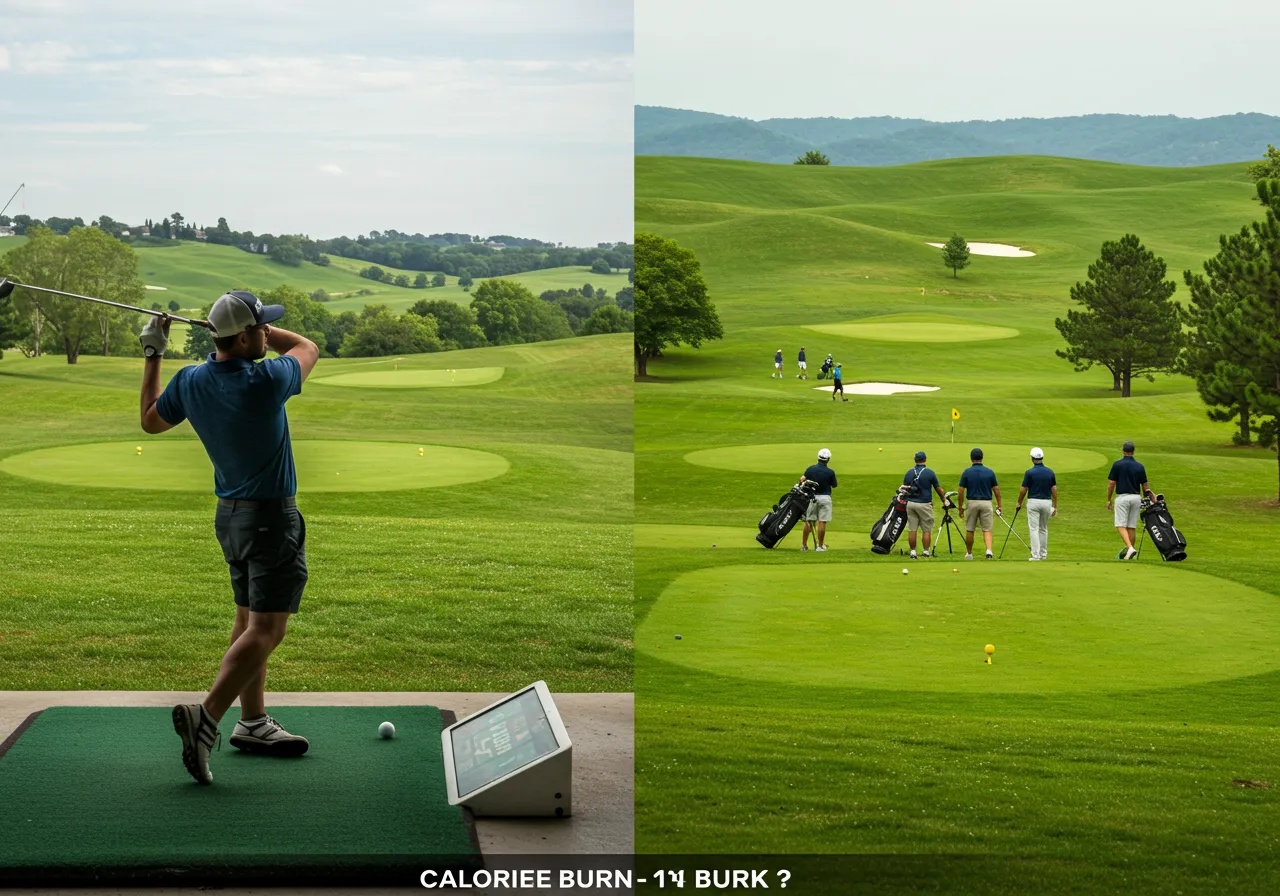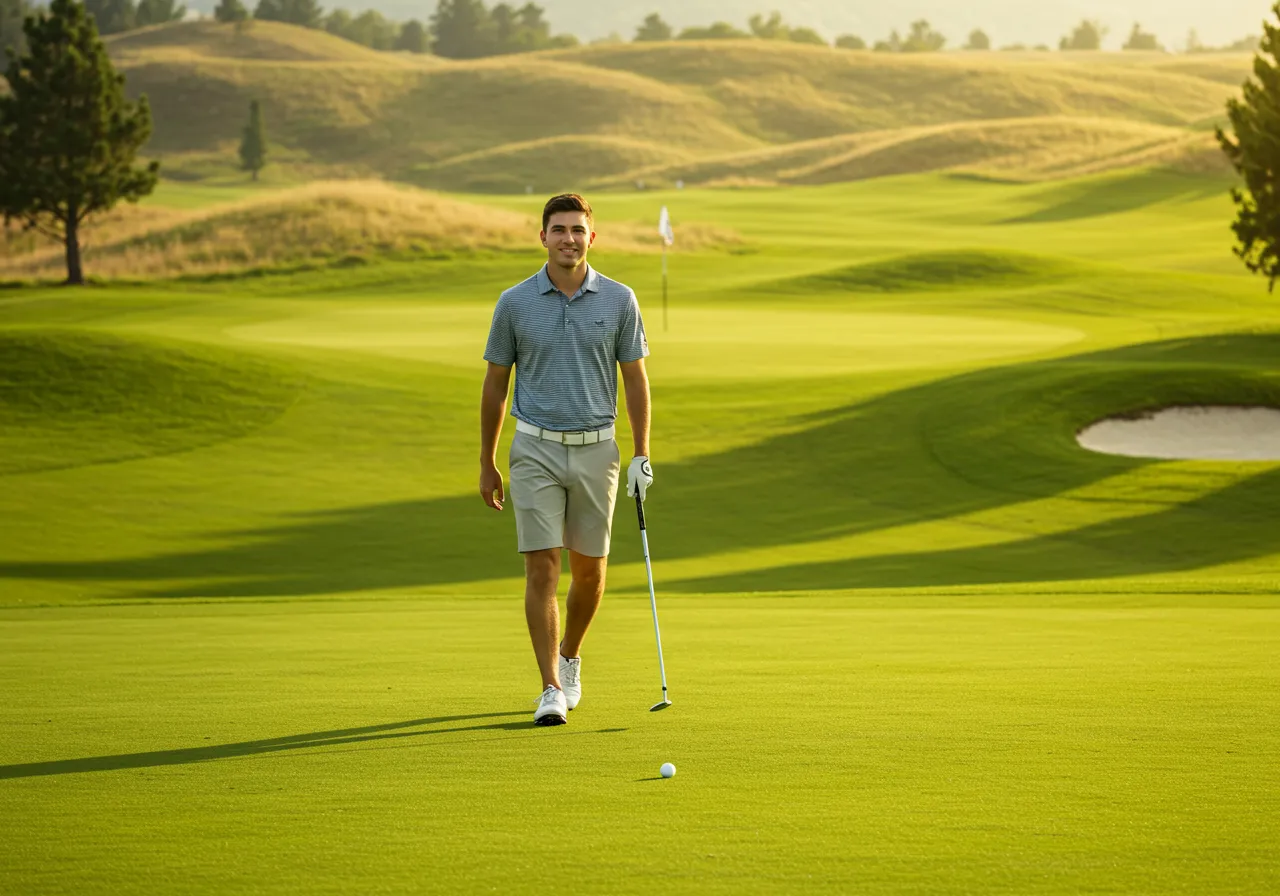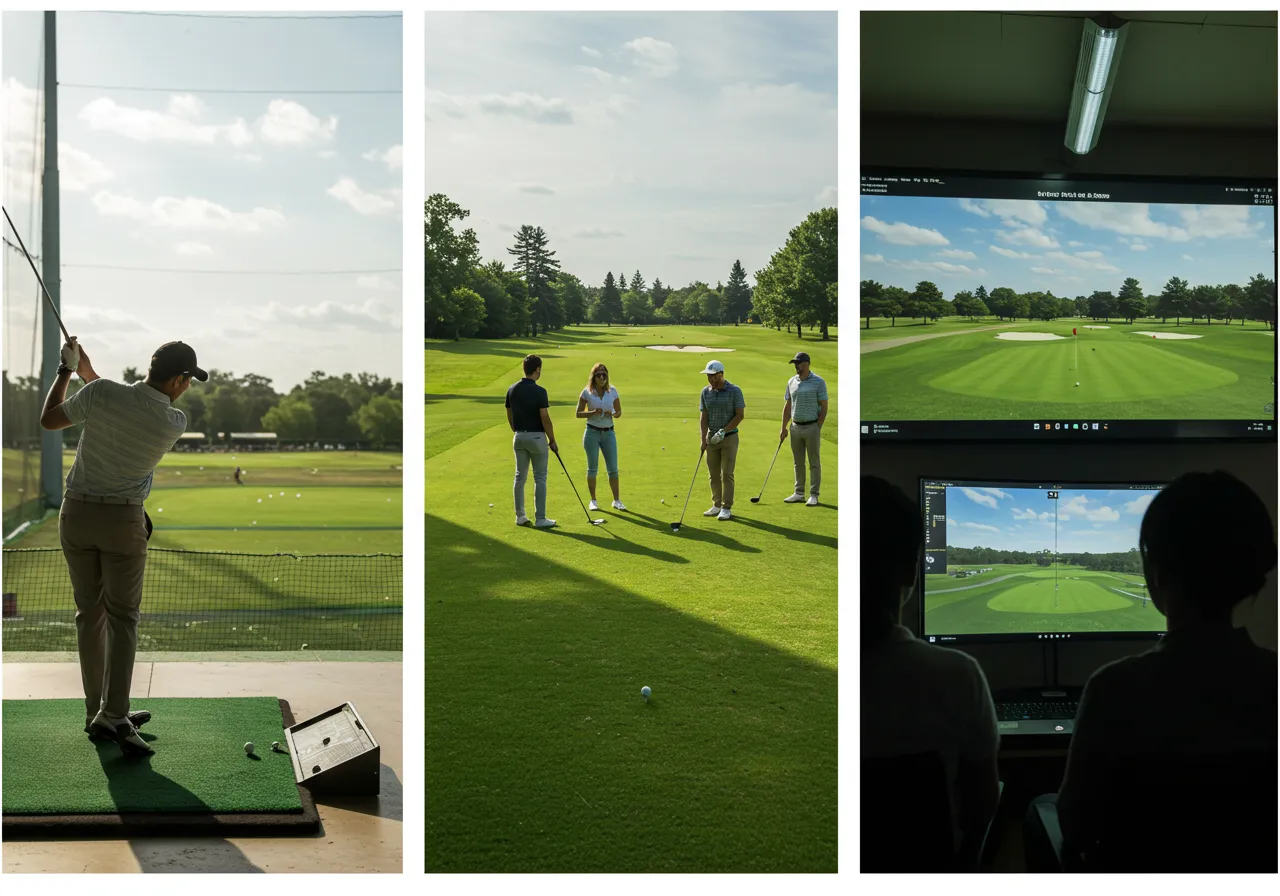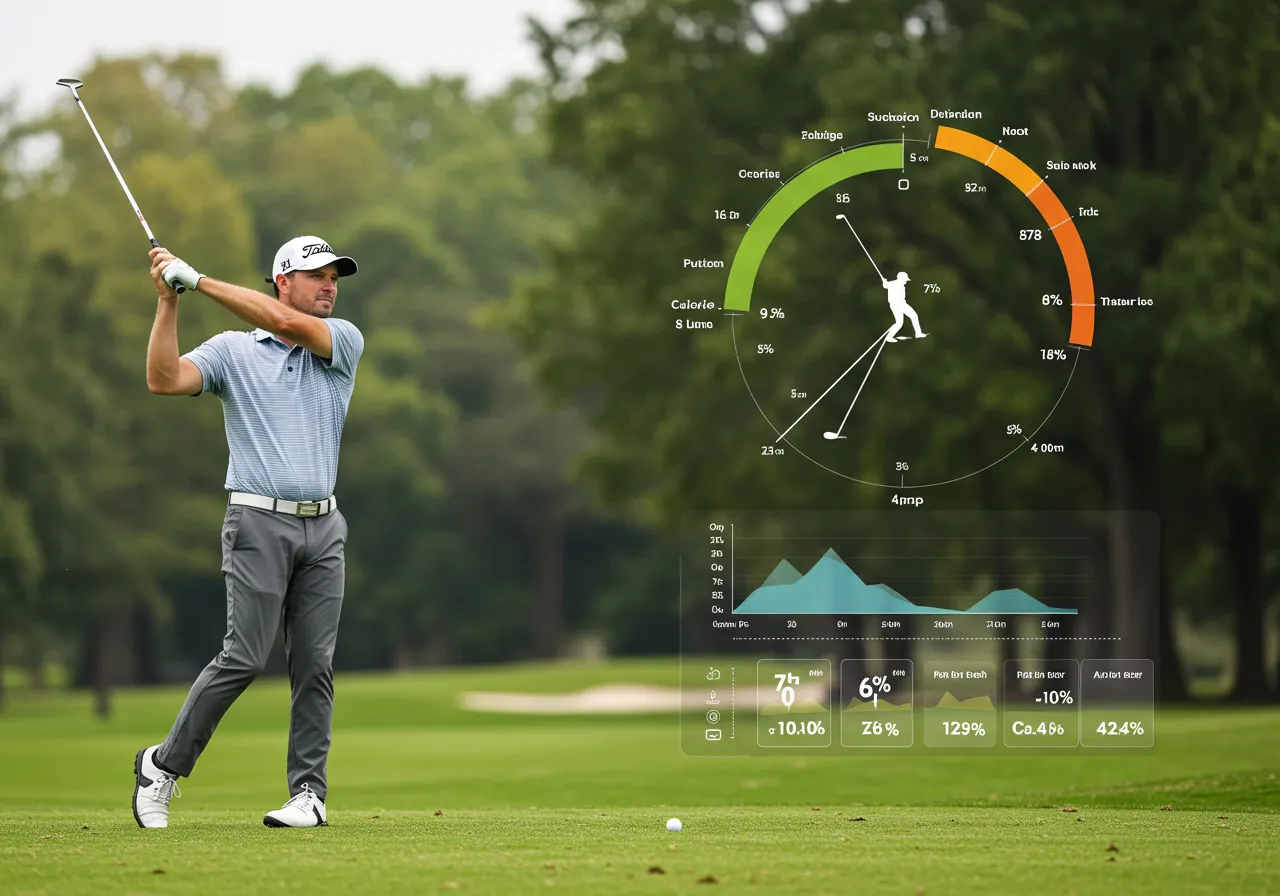How Many Calories Do You Burn Hitting Golf Balls
How many calories do you burn hitting golf balls? Most people burn about 200 to 500 calories per hour at the driving range. That’s around 2 calories for every ball you hit.
But it depends on a few things, like how hard you swing, how many balls you hit, your body weight, and if you’re walking or standing still.
If you hit 100 golf balls, you might burn 200 to 300 calories. Swinging harder and walking between shots can help you burn even more.
Heavier people also use more energy, so they burn more calories doing the same thing.
This article explains how many calories you burn hitting golf balls based on your weight, swing effort, and number of balls hit. It also compares driving range, full-course play, and simulator golf, with real numbers for 50, 100, and 200 balls.
You’ll learn if golf helps with weight loss and how walking, swinging, or using a cart affects your calorie burn.
Calories Burned at the Driving Range vs Playing a Full Round of Golf

I’ve tracked this during training sessions, and here’s what I’ve noticed:
| Activity | 150 lb (68 kg) | 200 lb (91 kg) | MET Value |
| Hitting 100 balls | 80 kcal | 110 kcal | 3.8 |
| 1-hour range session | 240 kcal | 320 kcal | 4.2 |
| Walking 18 holes | 1,400 kcal | 1,900 kcal | 5.2 |
| Simulator golf | 180 kcal | 240 kcal | 3.5 |
So yes, golf burns calories, especially if you walk instead of using a cart. Even indoor golf simulators help you stay active, though they burn a little less.
How Many Calories Do You Burn Hitting Golf Balls at the Driving Range
As a pro golfer who’s spent hours at the range, I can tell you, hitting golf balls is real exercise, especially if you’re serious about your practice.
You may not sweat like you do when running, but you’re burning more calories than you think.
How Many Calories Do You Burn Hitting 50, 100, or 200 Golf Balls
From my own experience, here’s what you can expect to burn:
- 50 balls: around 40–80 calories
- 100 balls: about 75–150 calories
- 200 balls: up to 150–300 calories
This depends on your body weight, how fast and hard you swing, and if you’re standing still or walking around between shots.
Why Swinging Golf Clubs Burns More Calories Than You Think
When I’m working on swing drills or hitting 100+ balls at the range, I’m using my shoulders, arms, legs, and core. That movement builds up over time.
Even small muscles are working when you grip the club or hold your balance.
Walking Between Shots Boosts Your Calorie Burn While Playing Golf

One trick I use to stay loose and burn more calories?
I walk instead of standing still between shots. It might not seem like much, but over an hour, it can add up to 100 extra calories burned.
Is Hitting Golf Balls a Good Workout
Yes, especially if:
- You hit a lot of balls (like 100 or more)
- You swing with effort
- You walk or move between shots
- You stay consistent with practice
It may not replace the gym, but it helps with fitness, flexibility, and burning calories — and it’s way more fun if you love golf.
If you’re trying to lose weight, stay active, or just add movement to your day, grab your clubs and head to the range.
Even 30 minutes of hitting balls can burn 100+ calories, depending on how you do it.
Want to take it further? Walk the course, skip the cart, and hit smart. Your body will thank you.
Calories Burned by Hitting 50, 100, or 200 Golf Balls Based on Your Weight
Here’s a simple chart based on what I’ve experienced and the data I’ve tracked:
| Balls Hit | 150 lb Player | 200 lb Player |
| 50 | 40–60 kcal | 55–80 kcal |
| 100 | 75–120 kcal | 110–160 kcal |
| 200 | 150–240 kcal | 220–320 kcal |
If I’m hitting 100–200 balls in a single session, especially with strong swings and short rest, I’m burning over 200 calories easily.
That’s just from swinging; if I walk between stations or carry extra clubs, it adds more.
What Affects the Number of Calories Burned While Hitting Golf Balls

A few things make a big difference in how many calories you’ll burn:
- Swing speed: Faster swings (like using a driver) burn more energy
- Club type: Heavier clubs like steel-shaft irons use more muscle
- Rest time: Shorter breaks between shots increase your calorie burn
- Movement: Walking instead of standing still adds extra activity
Even the difference between using a graphite shaft and a steel shaft can change how much effort your body puts in during a long session.
If you want to stay active and get more from your practice, treat your range session like a light workout. Swing with purpose, stay moving, and aim for 100 balls if you can.
It’s a great way to improve your game and burn some calories without needing a gym.
Is Hitting Golf Balls a Real Workout or Just Practice
From my years as a pro golfer, I can say this: golf practice isn’t just skill, it’s movement, and it works your body more than most people think.
When you’re hitting golf balls, you’re using your whole body, not just your arms. And when you swing again and again during a full range session, it really adds up.
How Much Muscle Does Golf Practice Use During a Range Session
Let’s break it down. Here’s how much your muscles work when you hit balls:
- Core muscles (like your abs and sides) are doing most of the work, around 68%
- Upper body (shoulders, arms, forearms) gets about 52%
- Lower body (legs and hips) still works too — about 35%
So even if it feels calm, you’re building strength, especially in your golf swing muscles like the core and shoulders.
Does Golf Help With Fitness and Heart Health
Yes, it does. I’ve worn a heart rate monitor during range sessions, and my average heart rate stays between 105 and 130 beats per minute.
That means it counts as a low to moderate cardio workout. Over time, this helps improve heart health and endurance.
Studies show hitting balls regularly can improve VO₂ max (your body’s ability to use oxygen) by up to 12% in just 8 weeks. That means more stamina for your game and everyday life.
Can You Lose Weight by Hitting Golf Balls

Let’s keep it real. One hour at the range burns about 300 calories. That’s the same as 1.5 slices of pizza. So no, you won’t lose weight overnight—but it does add up.
If you practice 3 times a week, that’s around 3,600 calories per month, which equals about 1 pound of fat loss if you stay consistent.
It’s not a fast fat-burner like running, but it’s a great option for people who enjoy golf and want to stay active without pushing too hard.
Golf practice is more than just a game. If you swing with focus, walk between shots, and keep up a steady pace, it becomes a legit workout that supports both your fitness goals and your game improvement.
You’re working muscles, getting your heart moving, and building healthy habits, all while doing something you love.
Golf Fitness Breakdown: Calories, Muscles, and Cardio Stats
| Activity / Metric | Data / Value | Source / Notes |
| Muscle Engagement (Core) | 68% | Obliques, transverse abdominis |
| Muscle Engagement (Upper Body) | 52% | Lats, deltoids, forearms |
| Muscle Engagement (Lower Body) | 35% | Glutes, quadriceps |
| Heart Rate During Range Practice | 105–130 bpm | Based on BetterMe and smartwatch data |
| VO₂ Max Improvement | Up to 12% over 8 weeks | Based on the Foy Golf Academy study |
| Calories Burned (1-Hour Range) | ~300 kcal | Varies by weight & swing effort |
| Calories in 1.5 Slices of Pizza | ~285 kcal | For comparison, the average fast food slice |
| Monthly Burn (3 sessions/week) | ~3,600 kcal | Equals ~1 lb fat loss per month |
Note: This table gives a realistic snapshot of golf practice as a workout.
Golf vs. Other Activities: How Many Calories Does Golf Really Burn
People often ask me, “Does golf burn as many calories as other sports?” The truth is, it can, especially if you’re walking the course or hitting a lot of balls.
As a pro golfer who trains regularly, I’ve tracked my calories with smartwatches and fitness apps, and here’s how golf stacks up against other common activities.
Calorie Burn Comparison: Golf vs Running, Walking, Basketball, and More
| Activity (1 Hour) | Calories Burned (150 lb person) | Golf Equivalent |
| Running (6 mph) | 600 kcal | Like hitting 250 full swings with driver |
| Playing Basketball | 480 kcal | About 200 shots with irons |
| Walking (3 mph) | 240 kcal | Same as hitting 100 range balls |
| Sleeping | 55 kcal | Around 20 putts |
| Golf (Range Session) | 200–400 kcal | Depends on the swing count and rest |
Golf may look slower, but those swings add up fast, especially when you’re doing 100+ reps in a session. Even putting in a little energy, believe it or not.
Range Practice vs Playing 18 Holes vs Virtual Golf

When I’m training, I don’t just stay at the range. I mix in walking full 18-hole rounds, cart rounds, and even some indoor simulator time. Here’s how they compare:
- Walking 18 Holes: You’ll walk about 5 to 7 miles, burning over 1,400 calories. That’s like doing cardio for 2 hours.
- Golf with a Cart: You still burn 300 to 500 calories, which is about 40% of what you’d burn walking.
- Golf Simulator: You can burn 180 to 340 calories, depending on how active your session is. I use one when the weather’s bad, still great practice, but less walking.
Golf doesn’t always feel like a workout, but when you track it, you’ll see the numbers add up.
If you swing with effort, skip the cart, and practice consistently, you can burn just as many calories as in other sports. Plus, you get fresh air, focus time, and a great swing along the way.
Simple Ways to Burn More Calories While Hitting Golf Balls
Want to burn more calories at the driving range without turning golf into a gym session?
As a pro golfer, I’ve picked up a few smart tricks over the years that help me stay in shape, just by practicing smarter. Here’s how you can get more out of your golf workouts.
Walk Between Hitting Stations to Increase Calorie Burn While Practicing Golf
When I walk to grab balls or switch mats, I notice I burn about 25% more calories than when I stay in one spot. It keeps my body moving and adds extra steps to my session.
Alternate Between Driver and Iron Swings to Boost Your Golf Workout
Alternating between powerful driver swings and controlled iron shots raises your heart rate and triggers something called EPOC (Excess Post-Exercise Oxygen Consumption).
That means your body keeps burning calories even after practice.
Use Weighted or Heavier Golf Clubs to Burn More Energy Per Swing
I sometimes use a weighted training club at the start of my session. It makes my normal clubs feel lighter and boosts the workout. Studies show it can raise your calorie burn by 5–10%.
Take Shorter Breaks Between Shots to Keep Your Heart Rate High While Practicing Golf

Instead of waiting a full minute between shots, I try to keep it to 30 seconds, like a mini workout circuit.
This steady rhythm keeps my heart rate up and burns more calories, just like Livestrong’s fitness plan suggests.
Practice Hitting Golf Balls in the Morning for Better Fat Burning
I usually hit the range in the morning when possible. Your body naturally burns more fat earlier in the day, up to 17% more fat oxidation, according to sports science. Plus, it feels great to start the day active.
Use a Golf Simulator with Swing Analytics to Track Intensity and Calories Burned
When I use a golf simulator, I don’t just look at ball speed; I track my swing effort, speed, and power.
Some systems even show your intensity level, which helps me push a little harder and stay accountable.
End Your Golf Practice With a 10-Minute Walk to Extend Calorie Burn
After 45–60 minutes of practice, I take a quick 10-minute walk before getting in the car.
This helps with metabolic priming, which means your body keeps burning calories longer even after you stop moving.
Golf doesn’t have to be passive. With just a few changes, less rest, more movement, and smarter drills, you can turn your range session into a fun and effective workout.
And the best part? You’re getting better at golf while getting fitter, too.
Table: 7 Ways to Burn More Calories During Golf Practice
| Strategy | What It Does | Estimated Calorie Impact |
| Walk between stations | Keeps the body moving between swings | Up to +25% more calories burned |
| Mix the driver and iron swings | Boosts heart rate and post-practice burn (EPOC) | Extended fat burn after practice |
| Use weighted clubs | Increases effort during the swing motion | +5–10% more MET value |
| Shorter rest between swings | Keeps heart rate elevated | Higher calorie burn per session |
| Practice in the morning | Improves fat-burning efficiency | +17% fat oxidation |
| Use the simulator swing analytics | Tracks intensity and pushes harder swings | Improves consistency + burn |
| Brisk 10-minute post-practice walk | Extends calorie burn after the session | Metabolic priming boost |
Note: These small changes don’t require extra equipment or intense training.
Driving Range Calorie Calculator: How to Estimate Calories Burned While Hitting Golf Balls

As a pro golfer, I like knowing how much energy I’m using during practice. It helps me plan better workouts and understand how my body’s reacting.
Here’s a simple formula I use to estimate how many calories I burn at the range.
Use This Golf Calorie Calculator Formula to Estimate Burn Per Session
Formula:
CALORIES = (MET × weight in kg × 3.5 × minutes) / 200
What it mean:
- MET is how intense your activity is. Golf ranges from 3.8 (casual) to 4.5 (intense swings)
- Weight in kg = Your weight in pounds ÷ 2.2
- Minutes = How long your practice session lasts
Example (Real-World Use):
If I’m 200 lbs, hit balls for 1 hour at a moderate intensity (MET 4.2), here’s the result:
→ Calories burned = (4.2 × 91 × 3.5 × 60) ÷ 200 = ~337 kcal
That’s about the same as going for a long walk or playing a light game of basketball.
Golf Fitness Trackers That Help You Measure Calorie Burn and Swing Data
When I want to track swings, effort, and calories in real-time, I use smart fitness tools.
These make a big difference in knowing how hard I’m training and how much I’m improving.
Garmin Approach S70: Best for Tracking Swing Count and Golf Sessions Automatically
I use the Garmin S70 because it tracks every swing without touching a button. It’s great for checking how many swings I take, my practice time, and calories burned.
WHOOP 4.0: Best for Tracking Strain, Recovery, and Calorie Burn During Golf
WHOOP 4.0 shows me how much “strain” my practice puts on my body. It helps me know when I’m pushing too hard or need recovery.
It also gives very accurate calorie burn numbers based on my heart rate.
Arccos Caddie: Best for Linking Golf Shots to Calorie Use

This system links with my clubs and app to track where each shot goes and how much energy I used during the round or range session.
It’s super helpful for both game strategy and fitness goals.
If you want to track your golf fitness seriously, start using a tracker during your range sessions.
If it’s swing count, heart rate, or calories, knowing your numbers helps you improve faster, both in your body and your game.
FAQs
How many calories do you burn hitting 100 golf balls?
You burn about 75 to 150 calories hitting 100 golf balls, depending on your body weight, swing intensity, and rest time between shots.
Does hitting golf balls at the range count as exercise?
Yes, hitting balls at the range is a form of light-to-moderate exercise. It engages your core, shoulders, and legs, and burns 150–400 calories per hour, depending on effort.
Can you lose weight by hitting golf balls?
Hitting golf balls regularly can help with weight loss if paired with a calorie-controlled diet. Practicing 3 times a week can burn around 3,600 calories per month, equal to roughly 1 pound of fat.
What burns more calories: golf or walking?
Walking generally burns more calories per minute, but a full round of golf while walking can burn 1,400+ calories, making it comparable to a brisk walk of 5–7 miles.
Does a golf simulator burn calories?
Yes, playing golf on a simulator burns about 180 to 340 calories per hour, depending on how active your session is. It’s less than outdoor golf due to reduced walking.
How much of a workout is playing 18 holes of golf?
Walking 18 holes of golf can burn over 1,400 calories, while riding in a cart burns about 300–500 calories, depending on how much you walk and swing.
How many calories do you burn while hitting golf balls?
You burn about 150 to 400 calories per hour while hitting golf balls at the driving range. The exact number depends on your body weight, swing speed, rest intervals, and how many balls you hit. On average, each ball burns around 1.5 to 2 calories during a standard range session.
Is golf a good exercise to lose weight?
Yes, golf is a great way to lose weight, especially if you walk and practice often. It’s low-impact but still burns calories.
If you hit golf balls for 1 hour, 3 times a week, you can burn around 3,600 calories in a month, which is close to losing 1 pound of fat, if you also eat healthy.
Why do you burn so many calories in golf?
Golf burns calories because your whole body moves. You swing, walk, and use muscles in your core, arms, and legs.
If you walk 18 holes or practice without long breaks, your heart rate stays up, and that helps your body use more energy.
Conclusion: Golf is More Than a Game, It’s a Calorie-Burning Activity
Hitting golf balls isn’t just practice; it’s real movement that burns calories, activates muscles, and supports long-term fitness.
If you’re swinging 50 or 200 times, walking the course, or using a simulator, every session adds up. It’s a simple, low-impact way to stay active and even lose weight over time.
Want to track your progress? Use a golf fitness tracker or calorie calculator to measure your sessions and stay on top of your goals, both in your swing and your health.
DRIVE THE GOLF BALL 20 YARDS FURTHER IN 20 MINS
Posts References:
How Many Calories Do You Burn Going Driving
Lose Weight Playing Golf – Burn Calories by Walking and